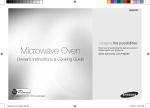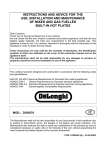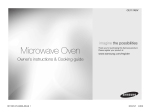Download Fisher & Paykel CG604DWFCX1 hob
Transcript
Installation instructions and User guide Gas cooktops CG604 & CG905 models NZ AU Contents Safety and warnings Installation instructions Introduction Using your cooktop Cooking guidelines and cookware Care and cleaning Troubleshooting Warranty and service Important! SAVE THESE INSTRUCTIONS The models shown in this document may not be available in all markets and are subject to change at any time. For current details about model and specification availability in your country, please visit our local website listed on the back cover or contact your local Fisher & Paykel dealer. 1 2 6 16 17 20 22 27 29 2 Safety and warnings Installation WARNING! Electrical Shock Hazard Before carrying out any work on the electrical section of the appliance, it must be disconnected from the mains electricity supply. Connection to a good earth wiring system is absolutely essential and mandatory. Alterations to the domestic wiring system must only be made by a qualified electrician. Failure to follow this advice may result in electrical shock or death. WARNING! Cut Hazard Beware of sharp edges when handling stainless steel appliances. Failure to use caution could result in injury or cuts. Safety and warnings 3 Important safety instructions! Installation Read these instructions carefully before installing or using this product. Please make this information available to the person responsible for installing the product as it could reduce your installation costs. This appliance shall only be installed and serviced by an authorised person. Incorrect installation, for which the manufacturer accepts no responsibility, may cause personal injury or damage and could invalidate any warranty or liability claims. This appliance must be installed in accordance with these installation instructions and in compliance with local gas fitting regulations, municipal building codes, water supply regulations, electrical regulations, AS5601/AG601 and NZS5261 – Gas installations and any other relevant statutory regulations. Do not modify this appliance. Models without flame failure protection MUST NOT be installed in marine craft, caravans or mobile homes. When this appliance is installed, it shall not be used as a space heater. No combustible materials or products should be placed on this appliance at any time. Do not spray aerosols in the vicinity of this appliance while it is in operation. This appliance should not be sealed into the bench with silicone or glue. Doing so will make future servicing difficult. Fisher & Paykel will not be liable for costs associated with releasing such a product, nor for repairing damage that may be incurred in doing this. Packing elements (eg plastic bags, polystyrene foam, staples, packing straps etc) and tools should not be left around during and after installation, especially if they are within easy reach of children, as these may cause serious injuries. 4 Safety and warnings Operation WARNING! Hot Surface Hazard This appliance becomes hot during use. Do not touch the cooktop components, burners, trivets, pan supports or the base when hot. Before cleaning, turn the burners off and make sure the whole cooktop is cool. Failure to follow this advice may result in serious injury. WARNING! Fire Hazard Never leave the appliance unattended when in use. Boilover causes smoking and greasy spillovers that may ignite. Never use your appliance for warming or heating the room. Failure to follow this advice may result in serious injury. WARNING! Explosion Hazard Models with no flame failure protection (CG604L, CG604C): If the flame is accidentally extinguished, turn the control dials and gas supply valve off immediately and thoroughly ventilate the room. Do not attempt to relight any burner until you are certain that all gas that may have escaped has dispersed. Do not use or store flammable materials such as gasoline near this appliance. Do not spray aerosols in the vicinity of this appliance while it is in operation. Failure to follow this advice may result in death or serious injury. WARNING! Electrical Shock Hazard Switch the power to the cooktop off at the wall before cleaning or maintenance. Failure to follow this advice may result in death or electrical shock. Safety and warnings 5 Important safety instructions! Operation Keep children away from the cooktop when it is in use. Household appliances are not intended to be played with by children. Children, or persons with a disability which limits their ability to use the appliance, should have a responsible person to instruct them in its use. The instructor should be satisfied that they can use the appliance without danger to themselves or their surroundings. If the electrical supply cord is damaged, it must only be replaced by an authorised person. Ensure that the electrical connection plug is accessible after installation. This appliance should be connected to a circuit that incorporates an isolating switch providing full disconnection from the electricity supply. Do not use an asbestos mat or decorative covers between the flame and the saucepan as this may cause serious damage to your cooktop. Do not place aluminium foil or plastic dishes on the cooktop burners. Do not let large saucepans or frying pans overlap the bench as this can deflect heat onto your benchtop and damage the surface. Do not let large saucepans, frying pans or woks push any other pans aside. This could make them unstable or deflect heat onto your benchtop and damage the surface. Do not use a steam cleaner for cleaning this cooktop. Saucepan handles may be hot to touch. Ensure saucepan handles do not overhang other gas burners that are on. Keep handles out of reach of children. Do not stand or place heavy objects on this appliance. After use, ensure that the control dials are in the ‘OFF’ position. This appliance shall not be used as a space heater, especially if installed in marine craft or caravans. The use of a gas cooking appliance results in the production of heat and moisture in the room in which it is installed. Ensure the kitchen is well ventilated. Keep natural ventilation holes open or install a mechanical ventilation device (mechanical extractor hood). Prolonged intensive use of the appliance may call for additional ventilation, for example opening of a window, or more effective ventilation, for example increasing the level of mechanical ventilation where present. After having unpacked the appliance, check to ensure that it is not damaged. In case of doubt, do not use it and consult your supplier or a professionally qualified technician. Packing elements (eg plastic bags, polystyrene foam, nails, packing straps, etc.) should not be left around within easy reach of children, as these may cause serious injuries. Some appliances are supplied with a protective film on steel and aluminium parts. This film must be removed before using the appliance. 6 Installation instructions A B E D C H J G I F J CG905DWAC I CG905DWFC A B C D E F G H CG604 Cooktop and cutout dimensions (mm) overall width of cooktop 578 914 914 overall depth of cooktop 511 533 546 height of chassis below top of bench 50 50 76 width of chassis 554 840 855 depth of chassis 480 480 470 overall width of cutout 560 870 870 overall depth of cutout corner radius of cutout distance from right edge of cutout to manifold centre line distance from rear edge of cutout to gas inlet 490 494 494 max. 10 max. 10 max. 10 30 30 30 40 47 35 Installation instructions 7 C E D A F B G CG604 CG905DWAC (mm) CG905DWFC Clearances H minimum clearance from left edge of cutout to: 140 140 100 nearest combustible surface minimum clearance from right edge of cutout to: B 140 140 100 nearest combustible surface minimum clearance from rear edge of cutout to: nearest combustible surface C 110 110 115 nearest non-combustible surface 20 30 35 minimum height of non-combustible material when used on D* adjacent walls 150 150 150 minimum clearance from pan supports to: rangehood 650 650 650 any other overhead exhaust fan E 800 800 800 downward-facing combustible surface (overhead cabinetry) 650 650 650 downward-facing tiled or fire-resistant surface 500 500 500 minimum clearance below top of benchtop to: nearest combustible surface F 60 60 81 F&P oven or nearest non-combustible surface 60 60 81 Ensure there is an earthed power outlet within 900 mm of the rear right-hand corner of the cookG top. The outlet should be accessible with the cooktop installed. If connecting the cooktop to the gas supply with a flexible hose, the connector on the wall should H be between 800-850 mm above the floor and to a distance of at least 250 mm outside the width of the cooktop. The connector should be accessible with the cooktop installed. A * See section ‘Standards requirements’ following. 8 Installation instructions Before you start Before starting to install the cooktop, make sure that: the cooktop has not been damaged during transport. In case of doubt after unpacking and checking it, contact the retailer the local distribution conditions (nature of gas and pressure) and the adjustment of the cooktop (as detailed on the appliance data label and in the ‘Gas rate and injector size table’ further below) are compatible the cooktop will be connected to a 220-240 V 50 Hz power supply and earthed via the power supply cable there is an earthed power outlet within the reach of the cooktop’s power supply cable (within 900 mm from the rear right of the cooktop, see dimension G in ‘Clearances’) the power outlet will be accessible after installation the power supply cable will not touch any hot metal parts a suitable isolating switch providing full disconnection from the mains power supply is incorporated in the permanent wiring, mounted and positioned to comply with local wiring rules and regulations. The isolating switch must be of an approved type and provide a 3 mm air gap contact separation in all poles (or in all active [phase] conductors if the local wiring rules allow for this variation of the requirements) the isolating switch will be accessible after installation the benchtop is made of a heat-resistant material exposed bare edges of the cutout are sealed with an oil-based paint or moistureproof polyurethane to prevent possible damage from moisture creeping between the cooktop trim and the benchtop. Standards requirements Temperature of nearby surfaces. Australian and New Zealand Gas Installation Standards (AS5601, NZS5261) require a cooktop to be installed so that the surface temperature of any nearby combustible surface will not exceed 65oC above ambient. This is typically achieved by: having the cooktop spaced away from the wall (see dimensions A, B, and C in ‘Clearances’) OR protecting the wall to a height of at least 150 mm along its length (see dimension D in ‘Clearances’) with non-combustible surface materials such as: - 5 mm-thick ceramic tiles—these alone are adequate - tempered glass or sheetmetal (minimum thickness 0.4 mm)—acceptable when used in front of a fire resistant material - F&P splashback (not available in Australia) when used with a 10 mm clearance from the rear edge of the cooktop to the front of the splashback (SB90 and SB1216 splashback models only). Note: these cooktops have been tested by an independent testing lab and meet standards requirements when installed to the dimensions in these instructions. Installation instructions 9 Fastening the cooktop to the bench This cooktop is suppled with fastening brackets (and screws) that will cope with a bench thickness of 20-50 mm. For benches thicker than 50 mm, recess the underside to a thickness of 20-50 mm. 50 mm 20 mm recessed to 50 mm Fig.1 Fastening the cooktop to the bench Connecting the cooktop to the gas supply Important! This cooktop is supplied factory-set for Natural Gas, but is suitable for installation with either Natural Gas or LPG, provided the injectors appropriate for the gas type are installed. Refer to the ‘Gas rate and injector size table’ for nominal ratings and appropriate injector sizes, and to section ‘Converting to a different gas type’. The gas connection must be carried out by a suitably qualified person according to the relevant standards. For Natural Gas, connect the gas supply to the gas pressure regulator supplied with the cooktop. Adjust the regulator to obtain a test point pressure of 1 kPa (4”W.C.) with the three largest burners operating at the highest setting. For LPG, connect the the gas supply to the test point adaptor supplied with the cooktop. Ensure that the supply pressure is regulated to 2.75 kPa (11” W.C.) See section ‘Converting to a different gas type’. Make sure the connection point will be accessible with the cooktop installed. To enable the gas supply to be readily shut off, make sure the connection is fitted with an isolating valve close to the cooktop. Attach the duplicate appliance data label on a surface adjacent to the cooktop, so that it will be easily read with the cooktop installed. For instructions on converting the cooktop for use with a different gas type, see section ‘Converting to a different gas type’. 10 Installation instructions Special requirements for CG604 and CG905DWFC models Gas connection to these cooktops MUST use the elbow supplied. The regulator will not seal if installed without it. Ensure the fibre washer (supplied) is located between the elbow (supplied) and cooktop gas inlet (Fig.2). Failure to use this washer will cause the connection to leak. Tighten the floating nut to firm finger tight, plus an additional ¼ turn (90o). Gas connection with a flexible hose If the gas is connected with a flexible hose, the connector on the wall should be between 800850 mm above the floor and to a distance of at least 250 mm outside the width of the cooktop. The connector should be accessible with the cooktop installed. Flexible hose assemblies should be AS/NZS 1869 Class B or Class D certified. The thread connection shall be Rp ½” (ISO 7-1) female (for CG604 and CG905DWFC models) or male (for CG905DWAC models). See Figs. 2 and 3. The hose assembly must be as short as practicable and comply with relevant AS 5601/NZS 5261 requirements. The hose must not be kinked, subjected to abrasion or permanently deformed. The hose must not be near or in contact with any hot surfaces (eg base of metal hotplate, flue or chassis of underbench oven etc). Fibre washer Elbow (1/2” BSP external thread) Fig.2 Gas connection to the cooktop (CG604 and CG905DWFC models) Gas inlet (1/2” BSP internal thread) Fig.3 Gas connection to the cooktop (CG905DWAC models) Installation instructions 11 Leak-testing and flame-testing the cooktop Important! The operation of the cooktop, including the ignition system, must be tested before installation is complete. If, after following the instructions below, satisfactory performance cannot be obtained, contact the local gas authority or your local Authorised Repairer for advice and assistance. 1 2 3 Checking the connections for leaks After installation and making all connections, check thoroughly for possible leaks and make sure all connections are gas-tight. Turn all control dials to O (OFF). Open the valve on the gas supply. Check each connection one at a time by brushing a soap and water solution or a suitable leak detection fluid over it. Important! Do not use any naked flames to check for leaks. The presence of bubbles indicates a leak. Tighten or replace connections as appropriate, then leak-test all connections again. For CG604 and CG905DWFC models, ensure the fibre washer (supplied) is located between the elbow and the cooktop’s gas inlet. 1 2 Checking the burner flames Light each burner. Check for a well-defined blue flame without any yellow tipping. See Fig.4. If any abnormality is evident, check that: - the burner cap is located properly - the injector nipple is correctly aligned - the correct size injectors are installed. Incorrect: flame ‘lifting off’ the burner Incorrect: yellow tipping Good flame: well-defined blue flame without yellow tipping Fig.4 Incorrect and good flame patterns 12 Installation instructions Converting to a different gas type Important! 1 Gas conversion may only be carried out by a suitably qualified person. To convert from one gas type to another, you need to replace the injectors and adjust the minimum burner setting. To replace the injectors, you will need a 7 mm box spanner (and a 10 mm ring spanner for CG905DWAC models). These are not supplied. Switch the power supply to the cooktop off at at the wall. Important! 2 3 4 5 Disconnect cooktop from the power supply before continuing. Make sure each control dial is turned to O (OFF). Remove all the pan supports and burner heads. Pull off the control dials. Using a 7 mm box spanner, remove the injectors and replace them with the correct ones (size numbers are stamped on the inside, eg 70=0.70 mm). Hold on to the card housing the replacement injectors for later use. CG905DWAC only 6 Remove all the screws holding the burners in place. 7 Carefully lift the hob tray off the cooktop. Important! 11 12 13 14 15 16 Beware of sharp edges. 8 Replace the wok burner injector with the correct one using a 10 mm ring spanner. Reset the venturi. Loosen the venturi screw, move the venturi towards the injector approx. 9 2 mm. 10 Refit the hob tray on the cooktop, repeating steps 6 and 7 in reverse. Check insulation resistance and earth continuity. Switch the power supply to the cooktop back on at the wall. Refit the control dials. Adjust the minimum burner setting. See section ‘Adjusting the minimum burner setting’ following. Check that all burners have a good flame (Fig.4). To indicate the gas type change, peel the adhesive label off the replacement injector card and stick it into the framed ‘gas type’ area on the appliance data label (on the underside of the cooktop). A second conversion label should also be affixed to the duplicate appliance data label. Installation instructions 13 Adjusting the minimum burner setting This has been adjusted at the factory for Natural Gas but may need adjusting for local conditions. When converting to LPG, the minimum setting MUST be re-adjusted for each burner. To adjust the minimum setting, you will need a Ø 2.5 x 45 mm screwdriver. 1 2 3 4 5 Light the burner and set the control dial to its minimum. Remove the dial. Slowly turn the adjustment screw inside the valve shaft until a minimum regular flame is achieved. Note: The flame will diminish when the screw is turned clockwise, and increase when turned anti-clockwise. The brass wok burner in the centre of CG905DWAC models may require progressive venturi adjustment (Fig. 6) until a good flame (Fig.4) is achieved: - If the flame is ‘lifting off’ the burner, move the venturi closer to the injector. - If there is yellow tipping, move the venturi away from the injector. Refit the dial. Check the minimum burner setting: quickly turn the dial from maximum to minimum. The flame must not go out. If it does, repeat the steps above. Repeat the steps above for each burner. Venturi NG venturi position LPG venturi position Fig.5 Adjusting the minimum burner setting Fig.6 Progressive venturi adjustment for the brass wok burner on CG905DWAC models 14 Installation instructions Gas rate and injector size table Test point pressure (kPa) Burners NATURAL GAS LPG 1.0 2.75 Injector Nominal orifice size gas rate (mm) (MJ/h@1kPa) Injector orifice size (mm) Nominal gas rate (MJ/[email protected]) CG604LC, CG604CWC, CG604DWFC, CG905DWFC Auxiliary (right front) 0.85 3.6 0.55 4.0 Semi-rapid (left & right rear) 1.30 8.5 0.80 8.5 Wok (left front in CG604CWC, CG604DWFC, left front & centre in CG905DWFC) 1.75 15.0 1.00 13.5 Rapid (left front in CG604LC) 1.55 12.0 0.95 12.0 Auxiliary (right front) 0.85 3.6 0.45 2.7 Semi-rapid (left rear) 1.22 7.2 0.70 6.2 Wok (centre) 1.90 16.3 1.10 15.3 Rapid (left front & right rear) 1.45 10.5 0.85 9.3 CG905DWAC Installation instructions 15 Final checklist TO BE COMPLETED BY THE INSTALLER Have you securely fastened the cooktop to the bench with the supplied brackets? All models except CG905DWAC: Have you used the supplied elbow and fibre washer to connect the gas to the inlet on the cooktop? Have you leak-tested all connections? Are the injector sizes correct for the gas type? Is the shut-off valve on the gas supply accessible to the customer? Is the power supply isolating switch accessible to the customer? Is the cooktop power supply cable plugged into an earthed outlet? Check the entire length of the power supply cable: it should not touch any hot metal parts. Have you removed all protective film from the stainless steel surfaces? Have you disposed of all packaging elements? OPERATION: Do all burners light individually and in combination? Do the burners remain lit when turned quickly from maximum to minimum? Are the flames consistent, free from any yellow tipping and appropriately sized? Have you demonstrated the basic operation to the customer? Installer’s name: Installer’s signature: Installation company: Date of installation: LEAVE THESE INSTRUCTIONS WITH THE CUSTOMER 16 Introduction About your new cooktop Thank you for buying a Fisher & Paykel gas cooktop. Once it is installed and ready to use, you will want to know everything about it to make sure you get excellent results right from the start. We recommend you read the whole guide before using your new cooktop, for both safety and cooking success. For more information, visit our local website listed on the back cover. Before using your new cooktop Read this user guide, taking special note of the ‘Safety and warnings’ section. Ensure the power supply to the cooktop is turned on. 5 5 1 1 1 2 4 3 Fig.7 Cooktop layout - CG604LC (no flame failure protection) 1 4 Fig.8 Cooktop layout - CG604CWC (no flame failure protection) and CG604DWFC (with flame failure protection) 5 5 1 1 1 2 3 3 3 2 4 Fig.9 Cooktop layout - CG905DWFC (with flame failure protection) 4 Fig.10 Cooktop layout - CG905DWAC (with auto-reignition) 1 2 3 4 5 Semi-rapid burner Rapid burner Wok burner Auxiliary burner Control dials Using your cooktop 17 Control dials The dials control the flow of gas through the valve. OFF (closed valve) NEVER cook or leave the dial between HIGH and O (OFF) NEVER cook or leave the dial between HIGH and O (OFF) HIGH OFF (closed valve) LOW HIGH ‘Burner On’ indicator Burner indicator LOW Fig. 11 Control dial for CG604 & CG905DWFC models Fig. 12 Control dial for CG905DWAC models Using the burners 1 2 3 Models with auto-reignition (CG905DWAC) Press the selected burner’s dial down gently and turn it anti-clockwise to HIGH. The ignitors on all the burners will spark. You do not need to hold the dial down. Adjust the flame anywhere between HIGH and LOW. Do not adjust between HIGH and O (OFF). After use, always turn the dials to O (OFF). Models with flame failure protection (CG905DWFC, CG604DWFC) 1 2 3 4 Press the selected burner’s dial down gently and turn it anti-clockwise to HIGH. The ignitors on all the burners will spark. Hold down the dial for about 5 seconds after the burner has lit. Releasing the dial too soon will extinguish the flame. Adjust the flame anywhere between HIGH and LOW. Do not adjust between HIGH and O (OFF). After use, always turn the dials to O (OFF). Fig. 13 Pressing down then 1 2 3 turning the control dial Models with no flame failure protection (CG604LC, CG604CWC) Press the selected burner’s dial down gently and turn it anti-clockwise to HIGH. The ignitors on all the burners will spark. Adjust the flame anywhere between HIGH and LOW. Do not adjust between HIGH and O (OFF). After use, always turn the dials to O (OFF). 18 Using your cooktop If a burner does not light Turn the control dial to O (OFF) and wait at least 1 minute before trying again. This is to allow the gas to disperse. If after trying again the burner still does not light, check that: the cooktop is plugged in and the power supply is switched on there is no power failure in your home or neighborhood the gas is turned on the gas bottle is not empty (if you use bottled gas) you have allowed at least 5 seconds for the valve to open when lighting the first burner (CG905DWAC models only) the ignitors are sparking. If they are not sparking, they may be dirty or wet. Clean them with a toothbrush and methylated spirits, as shown in Fig. 14 below. See ‘Care and cleaning’ for instructions on removing and replacing the burner parts. Flame failure probe (models with flame failure protection only) Ignitor Fig.14 Cleaning the ignitor and probe If the flame is irregular Check that the burner parts (flame spreader and burner cap) are: clean and dry positioned correctly, as shown in Figs. 15 and 16. For further advice, see sections ‘Care and cleaning’ and ‘Troubleshooting’. Burner cap Ignitor Flame spreader Fig.15 Burner parts Fig.16 Correct assembly of burner parts Fig.17 Incorrect assembly of burner parts, resulting in irregular flames Using your cooktop 19 If there is a power failure Models with auto-reignition (CG905DWAC) The gas supply will be cut off, even if a burner is in use. The cooktop cannot be used if there is a power failure. Wait until power is restored. If a control dial is still turned on when the power is restored, the corresponding ‘Burner On’ indicator light will flash rapidly. Turn the burner off and light it again to resume cooking. All other models (CG905DWFC, CG604DWFC, CG604LC, CG604CWC) You can still use your cooktop. Light the burners by holding a match close to the side of the burner and turning the control dial to HIGH. Wait until the flame is burning evenly before adjusting. If the flame is accidentally extinguished Models with auto-reignition (CG905DWAC) The auto-reignition system will detect this. The ignitors will spark and relight the burner. If no flame is detected after about 5 seconds, the gas supply to the cooktop will be cut off and the ‘Burner On’ indicator will flash slowly. In this event, turn the burner off and relight it to resume cooking. See also ‘Troubleshooting’. Models with flame failure protection(CG905DWFC, CG604DWFC) The flame failure protection will automatically cut the gas supply to the burner off. Turn the corresponding dial to O (OFF) and do not try to relight it for at least 1 minute (to allow the gas to disperse). 1 2 3 4 Models with no flame failure protection (CG604LC, CG604CWC) Immediately turn all control dials to O (OFF). Immediately turn the gas supply valve off. Ventilate the room thoroughly, to ensure that any gas that may have escaped can disperse. When you are certain that all gas has dispersed, you may turn the gas supply valve back on. Important! Do not attempt to relight any burner until you are absolutely certain that all gas that may have escaped has dispersed. 5 You may relight the burner(s). 20 Cooking guidelines and cookware Cooking guidelines Important! Never leave the cooktop unattended when in use. Boilover causes smoking and greasy spills that may ignite. Take care when deep-frying: oil or fat can overheat very quickly, particularly on a high setting. Start cooking on a high setting. When food comes to the boil, reduce the setting and maintain a steady heat to cook your food thoroughly. Doing this will reduce the cooking time. Using a lid will reduce cooking times through retaining the heat. Minimise the amount of liquid or fat to reduce cooking times. Cookware Use saucepans with thick flat bases. Food in a saucepan with an uneven base will take longer to cook. Do not let large saucepans or frying pans overlap the bench, as this can deflect heat onto your benchtop and damage its surface. Always make sure saucepans are stable. Using very heavy saucepans may bend the pan supports or deflect the flame. Make sure the size of the pan matches the size of the burner. A small pot on a large burner is not efficient.The following table shows the minimum and maximum saucepan base diameters that may be used on each burner: Burner Minimum ∅ Maximum ∅ Semi-rapid 12 cm - Rapid 18 cm 26 cm 18 cm 26 cm - 45 cm 12 cm - Wok regular pans woks Auxiliary Cooking guidelines and cookware 21 Using a wok – models with wok burner Use your wok only on a wok burner. On CG604CWC, CG604DWFC, and CG905DWFC models, a wok must always be used with the wok stand supplied. See Fig.18. The centre pan support of CG905DWAC models is shaped to take a traditional wok with a round base, but you may also use a wok stand for extra stability (not supplied, purchased optionally). Make sure the wok does not push any other pans aside. This could make them unstable, or deflect heat onto nearby walls or the benchtop. Important! Make sure that the wok stand is stable: its notches need to fit tightly on the grating. Note: to purchase additional wok stands, contact Customer Care. Fig.18 Using wok stand on CG905DWF and CG604DWF models (not supplied but purchased optionally for CG905DAWC models) 22 Care and cleaning Important! Before any cleaning or maintenance, always: turn all burners off switch the power to the cooktop off at the wall make sure that the cooktop and its parts are a safe temperature to touch. General advice Clean the cooktop regularly—do not let stains become burnt on. Do not use abrasive cleaners, cloths or pads to clean any part of your cooktop. Some nylon scourers may also scratch. Check the label. Make sure that no cleaner residue is left on any cooktop part; when heated, these could stain the cooktop. See the following pages for instructions on replacing the pan supports and reassembling the burners correctly after cleaning. Do not clean cooktop parts in a self-cleaning oven. Do not use a steam cleaner. What? How often? Stainless steel base After every use 1 2 3 4 5 Control dials As needed 1 2 How? Important! Soak any stubborn stains under a hot soapy cloth. Wipe the soiling off with a cloth using a mild household detergent or stainless steel cleaner. Wipe with a clean damp cloth. Wipe the surface dry with a microfibre cloth. For extra shine, use a suitable stainless steel polish. Hard water spots can be removed with household white vinegar. Do not use abrasive cleaners, steel soap pads or sharp objects on stainless steel. Always read the label to make sure that your stainless steel cleaner does not contain chlorine compounds as these are corrosive and may damage the appearance of your cooktop. Always rub the stainless steel in the direction of the grain. The graphics are etched onto the steel by laser and will not rub off. Wipe with a damp cloth and mild detergent. Dry thoroughly with a soft cloth. Do not use stainless steel or oven cleaner on the dials, as doing so may damage their coating. Care and cleaning How? Important! Remove the parts that you wish to clean. See the Figs. following for illustrations of removable burner parts. Soak stubborn stains in a solution of biological clothes washing detergent. Clean the parts in hot soapy water. Use a stiff nylon brush or straight-ended paper clip to clear the notches of a flame spreader. Rinse in warm water. Dry thoroughly. Replace the parts correctly, following Figs. 19-23. These parts are also dishwasher safe. To remove discolouration and for extra shine, clean the brass wok burner parts with brass cleaner (CG905DWAC models only). Make sure you keep the notches of the flame spreaders clear. Soiling may clog these and cause problems. Before replacing the burner parts, make sure that they are completely dry. Wet burner parts may result in an irregular flame. Before lighting a burner you have reassembled, check that all of its parts have been positioned correctly. Incorrect assembly can cause dangerous irregular flames and ignition problems. Clean these very carefully using a toothbrush and methylated spirits (see Fig. 14). The ignitor ensures trouble-free sparking and the probe ensures that the safety valves operate correctly. Check the ignitor and probe regularly to make sure they are clean. Note: only models with flame failure protection have probes. What? How often? Burner parts, pan supports, wok stand As needed, but at least once a month 1 2 3 4 5 6 Ignitor and probe At least once a month All gas components of the cooktop Once every 3-4 years 23 Contact your local Authorised Repairer to perform a thorough check on all gas components on the cooktop. For Authorised Repairer details, see your Service & warranty book or contact Customer Care. All checking and maintenance must be performed by a suitably qualified person. If the gas is connected with a flexible hose, checking should include inspecting the entire length of the flexible hose assembly for any sign of wear or damage. 24 Care and cleaning Replacing the pan supports correctly CG905 models The wok support goes in the centre, over the wok burner. The other two pan supports are interchangeable, but need to be rotated to match the rounded corners of the cooktop base. Fig.19 Correct positioning of pan supports (CG905 models) CG604 models The pan supports are interchangeable, but they can only be placed as shown and need to be rotated to match the rounded corners of the cooktop base. Fig.20 Correct positioning of pan supports (CG604 models) Care and cleaning 25 Replacing the burner parts correctly Semi-rapid, rapid, and auxiliary burners Cap Flame spreader Probe (some models only) Fig.21 Correct positioning of semi-rapid, rapid, and auxiliary burner parts Ignitor Wok burner with cast iron cap and ring (CG604 and CG905DWFC models) Fit the flame spreader to the housing as shown by the arrow in Fig.22 following. Make sure the burner is not able to rotate. Flame spreader Probe (some models only) Ignitor Cap Ring Fig.22 Correct positioning of cast iron wok burner parts 26 Care and cleaning Brass wok burner (CG905DWAC models only) Each part of the brass wok burner has locating pins to help you to assemble it correctly after cleaning. See Fig.23 below. Note: the brass parts of your wok burner will change colour with use. However, this will not affect performance and you can clean the brass parts with a brass cleaner. Inner cap Outer cap (small holes) Trim ring Vent ring with locating pins (large holes) Side view Rotate vent ring to align locating pin with hole in burner base. Align and insert pin Fig.23 Correct positioning of brass wok burner parts (CG905DWAC models only) Troubleshooting Problem A burner does not light. Possible solutions Check that the power to the cooktop is switched on at the wall and there is no power failure. Check the gas supply valve is turned on and the supply to the house is working. You should hear the gas when you turn a burner on. If you use bottled gas, check that it is not empty. The ignitors may be dirty. Clean them with a toothbrush and methylated spirits, as shown in Fig. 14. The burner parts may not be located properly. Check the assembly and make sure the burner cap is sitting flat. See ‘Care and cleaning’. The flames are yellow or hard to start. The burner parts may not be located properly. Check the assembly and make sure the burner cap is sitting flat. See ‘Care and cleaning’. If you use bottled gas, this may indicate you are getting near the end of the bottle. Check the burner parts are clean and dry. The gas pressure may not be at the correct level. Check this with your service person or installer. Your cooktop may not be set up for the gas you are using. Check this with your service person or installer. One of my burners has an uneven flame. Check the burner parts are clean and dry. The burner parts may not be located properly. Check the assembly and make sure the burner cap is sitting flat. See ‘Care and cleaning’. The flame goes out at low settings. The gas supply pressure may be low. Check this with your service person or installer. The low setting may have been adjusted incorrectly. Check this with your service person or installer. If you use bottled gas, this may indicate you are getting near the end of the bottle. My burners do not turn down much (when running on bottled gas or LPG). Your cooktop may not have been adjusted correctly. Check this with your service person or installer. The flame tips are very yellow. Call your service person to service the cooktop. 27 28 Troubleshooting Problem There is a power failure. CG905DWAC models only: All my ‘Burner On’ indicators are flashing. Possible solutions Models with auto-reignition (CG905DWAC) The gas supply will be cut off, even if a burner is in use. The cooktop cannot be used if there is a power failure. Wait until power is restored. If a control dial is still turned on when the power is restored, the corresponding ‘Burner On’ indicator will flash rapidly. Turn the burner off and light it again to resume cooking. All other models (CG905DWFC, CG604DWFC, CG604CWC, CG604LC) You can still use your cooktop. Light the burners by holding a match close to the side of the burner and turning the control dial to HIGH. Wait until the flame is burning evenly before adjusting. Turn all the control dials to O (OFF) and restart. Warranty and service 29 Before you call for service or assistance ... Check the things you can do yourself. Refer to the installation instructions and your user guide and check that: 1 2 Your product is correctly installed. You are familiar with its normal operation. If after checking these points you still need assistance, please refer to the Service & Warranty book for warranty details and your nearest Authorised Repairers, Customer Care, or contact us through our local website listed on the back cover. This cooktop has been designed and constructed in accordance with the following codes and specifications: In New Zealand and Australia: AGA101 (AS 4551) Approval Requirements for Domestic Gas cooking appliances AS/NZS 60335-1 General Requirements for Domestic electrical appliances AS/NZS 60335-2-6 Particular Requirements for Domestic electrical cooking appliances AS/NZS 1044 Electromagnetic Compatibility Requirements Model Serial no. Date of purchase Purchaser Dealer Suburb Town Country Copyright © Fisher & Paykel 2009. All rights reserved. The product specifications in this booklet apply to the specific products and models described at the date of issue. Under our policy of continuous product improvement, these specifications may change at any time. You should therefore check with your Dealer to ensure this booklet correctly describes the product currently available. www.fisherpaykel.co.nz www.fisherpaykel.com.au NZ AU Gas cooktop install instructions and user guide Published: 08/2009 Part No. 599572 A F&P Italy Part No. 1103373-ß1















































